 |
|
| (Information by Trish Wilson, with additional information from The La Tene Celtic Belgae Tribes in England: Y-Chromosome Haplogroup R-U152 - Hypothesis C, David K Faux, from The Celtic Encyclopaedia, Harry Mountain, from A Genetic Signal of Central European Celtic Ancestry, David K Faux, from Celts and the Classical World, David Rankin, from Europe Before History, Kristian Kristiansen, and from External Links: The Works of Julius Caesar: Gallic Wars, and Gran Enciclopedia Aragonesa (in Spanish), and Celtiberia.net (in Spanish), and Lista de pueblos prerromanos de Iberia (in Spanish, Hispanoteca.eu), and Euskomedia (in Spanish).) |
|
| 580 BC |
 Although it is strongly hinted that Iberian mercenary recruitment is already available, this is the first direct mention of it (see feature link). It comes in connection with the Sicilian Wars of 580-265 BC, a series of wars between Carthage and the Greek states of Sicily, notably Syracuse. By the end of the wars Rome has replaced the Greeks as the main Carthaginian opposition. Although it is strongly hinted that Iberian mercenary recruitment is already available, this is the first direct mention of it (see feature link). It comes in connection with the Sicilian Wars of 580-265 BC, a series of wars between Carthage and the Greek states of Sicily, notably Syracuse. By the end of the wars Rome has replaced the Greeks as the main Carthaginian opposition. 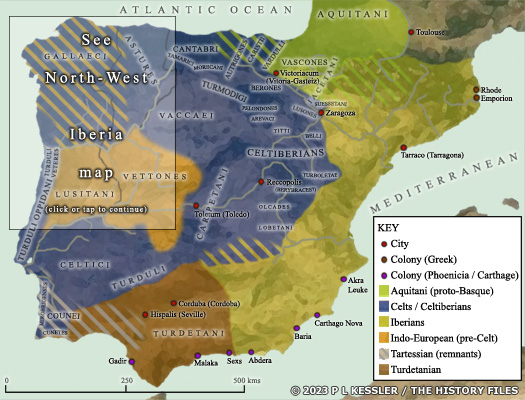 The Iberian peninsula prior to the Carthaginian invasion and partial conquest was a melange of different tribal influences (click or tap on map to view full sized) The Iberian peninsula prior to the Carthaginian invasion and partial conquest was a melange of different tribal influences (click or tap on map to view full sized) |
| 480 BC |
Hamilcar of Carthage lands a huge army on Sicily in order to confront Syracuse on the island's eastern coast. Despite their assembled forces and fierce Iberian mercenaries (their first mention in a specific battle), the Carthaginians are defeated by the Greeks at the Battle of Himera. A long struggle ensues with intermittent warfare between Carthage and Syracuse. |
| 396 BC |
When Hamilco of Carthage pulls out of Syracuse, abandoning his Iberian mercenaries, it is the Iberians who survive the subsequent massacre. They group together, march to Syracuse, and offer Dionysius 'the Elder' their services. This results in some of them becoming his personal bodyguard while his son, Dionysius II, who sends some of their mounted warriors to aid Sparta. |
| 274 BC |
Hiero II brings to an end the presence of Iberian mercenaries in Syracuse thanks to another upset which has been caused by riots. He sends them to tackle the Italian marauders who are known as the Mamertines and then withdraws his own forces, leaving them to their fate. 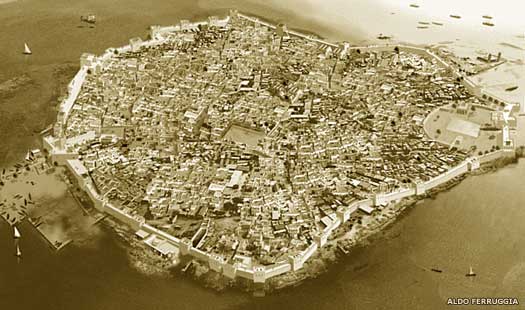 The colony of Motya (modern San Pantaleo), just off the western coast of Sciliy and close to Syracuse, changed hands twice during the revolt, with Ducetius of the Siculi at the centre of the fighting in his attempts to oppose Greek dominance The colony of Motya (modern San Pantaleo), just off the western coast of Sciliy and close to Syracuse, changed hands twice during the revolt, with Ducetius of the Siculi at the centre of the fighting in his attempts to oppose Greek dominance |
| 264 - 241 BC |
The First Punic War erupts between Rome and Carthage. It starts in Sicily and develops into a naval war in which the Romans learn how to fight at sea and eventually gain overall victory. Carthage loses Sardinia and the western section of Sicily. Carthage also has to quell subsequent dissent from Utica and its neighbouring city of Hippocritae, and the post-Punic Mercenary War in which Carthage's hired troops, mainly Iberian mercenaries, virtually go on strike for better pay. |
| 231 - 225 BC |
Rome has been informed of a forthcoming war with the Boii and Insubres tribes of northern Italy, so it hurries to assemble the legions. Even its ongoing conflict with the Carthaginians takes second place, and a treaty is hurriedly agreed with Hasdrubaal, commander in Iberia, which virtually confirms Carthaginian dominance there. 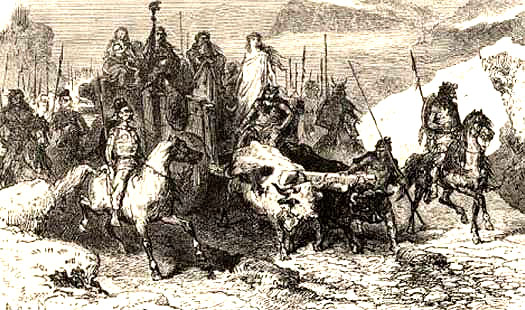 An idealised illustration of Gauls on an expedition, from A Popular History of France From The Earliest Times Volume I by Francois Pierre Guillaume Guizot An idealised illustration of Gauls on an expedition, from A Popular History of France From The Earliest Times Volume I by Francois Pierre Guillaume Guizot |
| 221 - 219 BC |
Hannibal assumes command and spends two years consolidating Carthage's conquest of Iberia south of the Ebro. The Carpetani are amongst the first to be attacked by them. Rome perceives this as a threat and makes an alliance with the Edetani city of Saguntum (near modern Valencia), south of the Ebro. This is a clear violation of Hasdrubaal's treaty so, assisted by the Turboletae, Hannibal besieges the city until it surrenders eight months later. Rome affects outrage and demands justice from Carthage. Instead, Hannibal is supported and the Second Punic War begins. Hannibal benefits from assistance which is provided by Iberian mercenaries. |
| 218 - 202 BC |
The Second Punic War starts at Saguntum (near modern Valencia) in Hispania when the Turboletae assist Carthage in sacking this Edetani city during the final assault. Using Gadir as a base, Hannibal Barca sets out to attack Rome, leading his armies over the Alps into Italy. 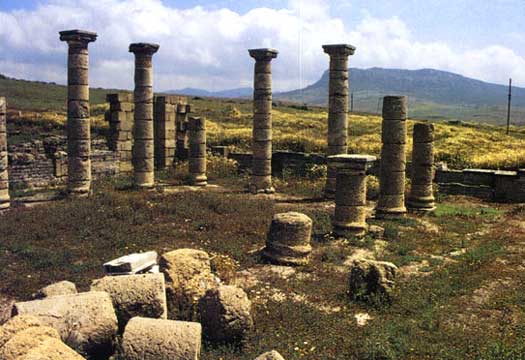 The surviving ruins of the Phoenician city of Gadir are few in number although some signs of them can be found, but did these pillars provide a name for the nearby 'Pillars of Heracles' (the modern Straits of Gibraltar) thanks to Hercules himself supposedly completing one of his labours here? The surviving ruins of the Phoenician city of Gadir are few in number although some signs of them can be found, but did these pillars provide a name for the nearby 'Pillars of Heracles' (the modern Straits of Gibraltar) thanks to Hercules himself supposedly completing one of his labours here? |
| At first he wins great victories at Trasimeno and Cannae which all but destroys Roman military strength, but he is denied the reinforcements to pursue his victory by an opposing political faction back at home. The majority of Rome's Italian allies remain loyal and Rome is able to rebuild its strength. In 206 BC, Gadir is lost. In 203 BC the Carthaginians lose the Battle of the Great Plains when their forces are routed. Their Iberian mercenaries stand firm and fight to the very end, determined not to be picked off while running away or subjected to the horrors of capture and execution. In 202 BC an enemy force is landed in North Africa, thanks to which Hannibal is defeated by Scipio Africanus at the Battle of Zama, thereby ending the war. |
|
| c.200s BC |
In the form of expert slingers, the people of the Balearics serve as Iberian mercenaries, first under the Carthaginians and then later under the Romans. They go into battle ungirt, with only a small bucker and a javelin which has been file-sealed at the tip and is only sometimes topped with an iron cap. 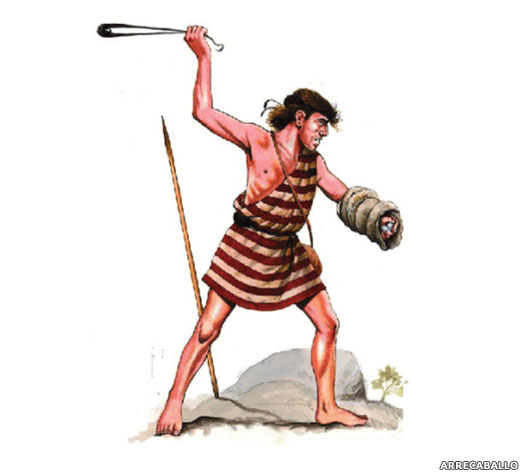 The effective weapon of the Balearic warrior was the sling, with each man carrying three, wound around the head according to Strabo or, according to Diodorus, one around the head, one around the body, and one in the hand The effective weapon of the Balearic warrior was the sling, with each man carrying three, wound around the head according to Strabo or, according to Diodorus, one around the head, one around the body, and one in the hand |
| 154 - 133 BC |
The Numantine War is the final major conflict in the Celtiberian Wars. It is triggered in 154 BC when the Celtiberians of Numantia revolt against Roman domination. The Lusitanian War takes place alongside it, both helped along by large numbers of Iberian mercenaries. A lull occurs between 151-143 BC before the Numantine War flares up again. The Arevaci are the principle participants but in the end it is largely a case of unified Celtiberians against Romans. In 137 BC when a combined Cantabri-Vaccaei contingent is on its way to counter a siege of Numantia (primarily the home of the Pelondones), such is the panic in the Roman lines that the commander, Consul Gaius Hostilius Mancinus, is forced to surrender on humiliating terms. However, the final, now-hopeless siege of Numantia sees many of the Celtiberian defenders commit suicide rather than surrender. 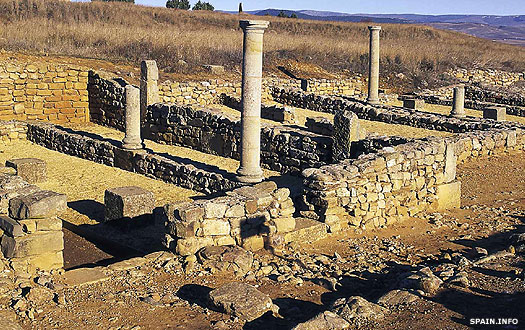 The city of Numantia dates back in its earliest form to around 2000 BC, with Celtiberian control beginning in the first millennium BC when the Arevaci tribe built a grand stone-and-mud city over the earlier site, although today only the later, Roman city is generally visible The city of Numantia dates back in its earliest form to around 2000 BC, with Celtiberian control beginning in the first millennium BC when the Arevaci tribe built a grand stone-and-mud city over the earlier site, although today only the later, Roman city is generally visible |
| 27 BC - AD 14 |
During the period of office of Augustus in Rome, the Iberian tribes are organised into provinces. Iberian mercenaries know a good thing when they see it and continue to sign up for mercenary duties, now enlisting into formal Roman auxiliary units. These take the form of alae (cavalry units), cohortes peditatae or simply cohortes (infantry units), and cohortes equitatae (infantry with an attached cavalry contingent). In time, following the fading of late Roman imperial authority, Iberia is incorporated into the vast Visigoth kingdom. |
 |
|
 According to ancient texts, the Iberian mercenary way of life had been taking place since the advent of the Iron Age, particularly central Iberia and the Early Balearic Islands. Becoming a soldier of fortune was a way of escaping poverty and finding opportunities to exercise warrior traditions (see feature link). From the fifth century BC onwards, the mercenary way of life became a true social phenomenon in Iberia, causing many from the peninsula to seek their fortune elsewhere by enlisting in foreign armies. The reasons for this were mainly economic. The main regions for men to sell their services could be found in Roman-era Lusitania and amongst the Celtiberians where cultivable terrain was largely governed by a few landowners. However, the long history of tribal warfare also played its part. Natives from the Balearic Islands and mountain folk such as the Cantabri were also recognised as having a strong mercenary tradition. Strabo and Thucydides considered them to be amongst the best fighting forces in the Mediterranean, while Livy described them as the flower of Hannibal's army. Polybius thought that Iberian mercenaries had been the reason behind several Carthaginian victories during the Second Punic War between 218-202 BC. They provided cavalry as well as infantry, being known for their equestrian skills.
According to ancient texts, the Iberian mercenary way of life had been taking place since the advent of the Iron Age, particularly central Iberia and the Early Balearic Islands. Becoming a soldier of fortune was a way of escaping poverty and finding opportunities to exercise warrior traditions (see feature link). From the fifth century BC onwards, the mercenary way of life became a true social phenomenon in Iberia, causing many from the peninsula to seek their fortune elsewhere by enlisting in foreign armies. The reasons for this were mainly economic. The main regions for men to sell their services could be found in Roman-era Lusitania and amongst the Celtiberians where cultivable terrain was largely governed by a few landowners. However, the long history of tribal warfare also played its part. Natives from the Balearic Islands and mountain folk such as the Cantabri were also recognised as having a strong mercenary tradition. Strabo and Thucydides considered them to be amongst the best fighting forces in the Mediterranean, while Livy described them as the flower of Hannibal's army. Polybius thought that Iberian mercenaries had been the reason behind several Carthaginian victories during the Second Punic War between 218-202 BC. They provided cavalry as well as infantry, being known for their equestrian skills.  In contrast to the warfare of various imperial powers around the Mediterranean, Iberian warfare was more banditry and less pitched battles (see feature link). Warriors could be loyal followers, vassals, or mercenaries. It is due to this that Iberian armies were usually small in comparison to the great Mediterranean powers, often being formed around specific chieftains and war leaders.
In contrast to the warfare of various imperial powers around the Mediterranean, Iberian warfare was more banditry and less pitched battles (see feature link). Warriors could be loyal followers, vassals, or mercenaries. It is due to this that Iberian armies were usually small in comparison to the great Mediterranean powers, often being formed around specific chieftains and war leaders.  Iberian women did not serve as mercenaries but, even so, there are numerous reports regarding them taking part in fighting, just as they did in Celtic tribes to the north of Iberia (see feature link). The mindset which the Romans never really seemed to get a grip on was that - if forced by circumstances - Celtic and Iberian women alike could inflict damage on Roman martial pride (Boudicca and many others).
Iberian women did not serve as mercenaries but, even so, there are numerous reports regarding them taking part in fighting, just as they did in Celtic tribes to the north of Iberia (see feature link). The mindset which the Romans never really seemed to get a grip on was that - if forced by circumstances - Celtic and Iberian women alike could inflict damage on Roman martial pride (Boudicca and many others).  Iberian mounted warriors were renowned for their equestrian skills, much of that due to the horses they bred, trained, and rode (see feature link). Roman writers continually extolled Iberian horses, describing them as fast, strong, and well-tamed, swift and sure-footed on mountainous routes so that they left behind any Italian counterparts. Horses were trained to remain in place if their riders were to dismount in the middle of a battlefield (Ilergetae and Celtiberians were especially fond of doing this, while still being able to make a quick getaway). Iberian mercenaries did not enlist individually but in small units which were made up of friends, relatives, and neighbours. They would generally remain under the authority of their own commanders and would retain their weapons, tactics, and traditions. The mains centres of recruitment were Baria, Cástulo, Empuries, Gadir, and the Balearic Islands. Once candidates had assembled, the recruitment process would be overseen by special emissaries from Carthage, Syracuse, or whichever Mediterranean power was doing the recruiting. They were known for their toughness, discipline, and skill, as well as for the quality of their weapons, and no less for their ferocity.
Iberian mounted warriors were renowned for their equestrian skills, much of that due to the horses they bred, trained, and rode (see feature link). Roman writers continually extolled Iberian horses, describing them as fast, strong, and well-tamed, swift and sure-footed on mountainous routes so that they left behind any Italian counterparts. Horses were trained to remain in place if their riders were to dismount in the middle of a battlefield (Ilergetae and Celtiberians were especially fond of doing this, while still being able to make a quick getaway). Iberian mercenaries did not enlist individually but in small units which were made up of friends, relatives, and neighbours. They would generally remain under the authority of their own commanders and would retain their weapons, tactics, and traditions. The mains centres of recruitment were Baria, Cástulo, Empuries, Gadir, and the Balearic Islands. Once candidates had assembled, the recruitment process would be overseen by special emissaries from Carthage, Syracuse, or whichever Mediterranean power was doing the recruiting. They were known for their toughness, discipline, and skill, as well as for the quality of their weapons, and no less for their ferocity.
 Although it is strongly hinted that Iberian mercenary recruitment is already available, this is the first direct mention of it (see feature link). It comes in connection with the Sicilian Wars of 580-265 BC, a series of wars between Carthage and the Greek states of Sicily, notably Syracuse. By the end of the wars Rome has replaced the Greeks as the main Carthaginian opposition.
Although it is strongly hinted that Iberian mercenary recruitment is already available, this is the first direct mention of it (see feature link). It comes in connection with the Sicilian Wars of 580-265 BC, a series of wars between Carthage and the Greek states of Sicily, notably Syracuse. By the end of the wars Rome has replaced the Greeks as the main Carthaginian opposition.  The Iberian peninsula prior to the Carthaginian invasion and partial conquest was a melange of different tribal influences (click or tap on map to view full sized)
The Iberian peninsula prior to the Carthaginian invasion and partial conquest was a melange of different tribal influences (click or tap on map to view full sized) The colony of Motya (modern San Pantaleo), just off the western coast of Sciliy and close to Syracuse, changed hands twice during the revolt, with Ducetius of the Siculi at the centre of the fighting in his attempts to oppose Greek dominance
The colony of Motya (modern San Pantaleo), just off the western coast of Sciliy and close to Syracuse, changed hands twice during the revolt, with Ducetius of the Siculi at the centre of the fighting in his attempts to oppose Greek dominance An idealised illustration of Gauls on an expedition, from A Popular History of France From The Earliest Times Volume I by Francois Pierre Guillaume Guizot
An idealised illustration of Gauls on an expedition, from A Popular History of France From The Earliest Times Volume I by Francois Pierre Guillaume Guizot The surviving ruins of the Phoenician city of Gadir are few in number although some signs of them can be found, but did these pillars provide a name for the nearby 'Pillars of Heracles' (the modern Straits of Gibraltar) thanks to Hercules himself supposedly completing one of his labours here?
The surviving ruins of the Phoenician city of Gadir are few in number although some signs of them can be found, but did these pillars provide a name for the nearby 'Pillars of Heracles' (the modern Straits of Gibraltar) thanks to Hercules himself supposedly completing one of his labours here? The effective weapon of the Balearic warrior was the sling, with each man carrying three, wound around the head according to Strabo or, according to Diodorus, one around the head, one around the body, and one in the hand
The effective weapon of the Balearic warrior was the sling, with each man carrying three, wound around the head according to Strabo or, according to Diodorus, one around the head, one around the body, and one in the hand The city of Numantia dates back in its earliest form to around 2000 BC, with Celtiberian control beginning in the first millennium BC when the Arevaci tribe built a grand stone-and-mud city over the earlier site, although today only the later, Roman city is generally visible
The city of Numantia dates back in its earliest form to around 2000 BC, with Celtiberian control beginning in the first millennium BC when the Arevaci tribe built a grand stone-and-mud city over the earlier site, although today only the later, Roman city is generally visible